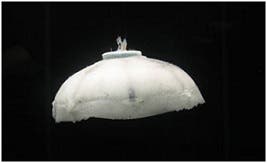After a three year effort, researchers at Virginia Tech have successfully managed to create a silicone robot that functions underwater by mimicking the motion of a jellyfish. The robot can propel itself thanks to the heat-producing reactions catalyzed by its surface, and since it uses hydrogen and oxygen found in the water as fuel, the Robojelly can theoretically swim indefinitely in an ocean.

The Robojelly’s platinum-based surface catalyzes the hydrogen in exothermic reactions which generate heat. This is heat is then transferred to the robot’s actuators which replicate the real jellyfish’s muscles; circular artificial muscles contract the bell, the jellyfish’s quasi-head cap, thus expelling water and propelling the contraption forward.
The actuators are made out of Bio-Inspired Shape memory Alloy Composites (BISMAC) – nickel-titanium shape memory alloy wrapped with multi-wall carbon nanotube sheets which are themselves coated with a catalytic platinum powder. The byproduct of the hydrogen reaction is vaporized water, completely harmless to the environment.
“To our knowledge, this is the first successful powering of an underwater robot using external hydrogen as a fuel source,” said Yonas Tadesse, lead author of a Robojelly study
The Robojelly has been in development since 2009, and has received funding from the Office of Naval Research. This vehicle will have a broad range of applications for both military and civilian uses. Most likely, the study will pave the way for the deployment of unmanned surveillance submarines. Check out a video of the Robojelly in action below.
The findings were reported in the journal Smart Materials and Structures.
source


